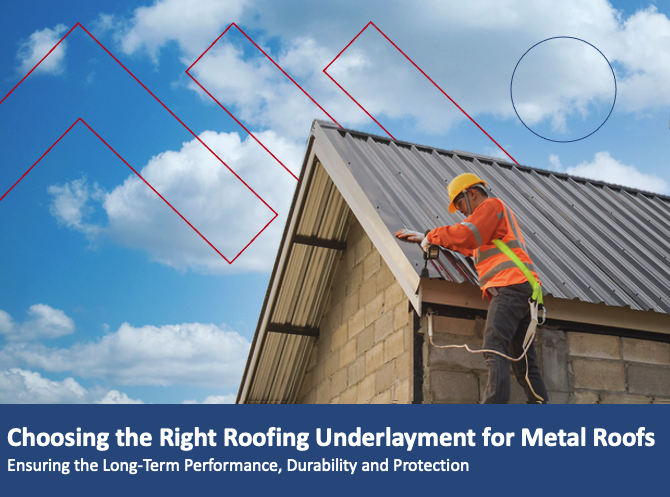BEST UNDERLAYMENT CHOICE FOR METAL ROOFS

How to Choose the Right Roofing Underlayment for Metal Roofs
When it comes to metal roofing, selecting the appropriate underlayment is crucial for ensuring the long-term performance, durability, and protection of your roof. Roofing underlayment is a secondary layer installed beneath the primary roofing material, and it acts as a barrier against water infiltration, condensation, and other potential issues. Different roofing materials require specific underlayment types, and when it comes to metal roofs, there is one type that stands out as the most suitable option: synthetic underlayment.
Water Resistance: Metal roofs are designed to shed water efficiently. Synthetic underlayment is inherently waterproof, preventing any moisture from seeping through and causing damage to the underlying structure of the roof.
Lightweight: Compared to traditional felt underlayment, synthetic alternatives are much lighter. This is particularly advantageous for metal roofs, which are already relatively lightweight. Using a lightweight underlayment ensures that the roofing structure remains well-supported without adding unnecessary stress.
UV Resistance: Metal roofs are highly reflective, meaning they absorb less heat from the sun. Synthetic underlayment is UV-resistant, ensuring it won't degrade or break down under prolonged exposure to sunlight, which can be a concern with other underlayment materials.
Tear and Puncture Resistance: Metal roofs can expand and contract with temperature changes, making them more susceptible to damage caused by stretching and movement. Synthetic underlayment is highly tear and puncture-resistant, providing an extra layer of protection against potential abrasions during installation or from external forces.
On the other hand, traditional felt underlayment, although commonly used for asphalt shingle roofs, is not the best option for metal roofs due to some inherent drawbacks:
Absorbs Moisture: Felt underlayment is susceptible to moisture absorption. If any water manages to get through the metal roofing, the felt may absorb it, potentially leading to issues like rot, mold, or a compromised roofing structure.
Less UV Resistant: Felt underlayment is less effective in resisting UV rays, which can lead to premature degradation and necessitate more frequent replacements.
Heavier: Felt underlayment is significantly heavier than synthetic options. The extra weight could strain the roofing structure, especially with metal roofs that are designed to be lightweight.
Limited Tear Resistance: Compared to synthetic underlayment, felt is more susceptible to tearing or puncturing, which could be problematic during installation or if the roof experiences any external impact.
Proper installation practices and choosing quality materials like TuffDry, can make a significant difference in the overall performance and longevity of your roofing system
Tuffdry offers two types of synthetic underlayment, the first is synthetic underlayment that is mechanically nailed to the roof substrate as well as peel and stick options depending on your needs. Reach out to us if you have any questions our would be interested in a sample
